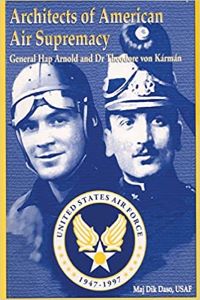- AFHF Member Authors, USAF Academy Department of History
Architects of American Air Supremacy: General Hap Arnold and Dr. Theodore von Kármán
by Dik A. Daso
This study highlights elements of technology with which Henry H. Arnold and Theodore von Kármán were directly involved. Very little is included covering specific air operations during World War II, although technology was certainly vital to them. Little is included concerning scientific achievement outside of the framework of the Army Air Forces, although the effect of military technological development on the civilian world, during and particularly after the war, is indisputable. More significantly, the evolution of American science itself, from empiricism to a more German, theoretical approach to problem solution, is only indirectly addressed through the evolution of airpower. The biographical approach, emphasizing scientific and technological elements in Arnold’s and Kármán’s lives, is essential because the interaction of personalities, as well as their institutions, is inexorably linked to the development of American airpower. The importance of the personalities involved precludes a purely technological history of the airplane or the Air Force as a system within itself. For in the end, it was two men using their broad experience and innovative ideas, who created the blueprint with which American air supremacy has been built. A major theme of this study is how people influence each other. Consequently, decisions affecting institutions are molded, not just by experience but also by personal influences. This is a history of ideas. It is an examination of how the Air Force has come to believe itself a military service with its base firmly anchored in advanced technology and how those beliefs originated. Additionally, it is the story of how airpower technologies evolved through World War II. Scientists had a hand in technological development, but not the only hand, Government officials directed and funded scientific and technological research. University professors, a large part of the scientific community, accomplished much of the essential research. This posed an interesting problem for Kármán because, traditionally, American science had revolved around utilitarian values rather than theoretical understanding of both practical and scientific problems. l Industry provided the brawn required to mount the massive buildup of World War II military forces. But interaction of all of these, shaped by perceptions, vision, and interpersonal experiences, directed the actual evolution of airpower. 2 Underlying the major themes in this study is the realization that an integral part of this technological evolution was frequently the result not of superior planning or wisdom, but of good fortune, or dumb luck and happenstance. The Army Air Corps, while led by Arnold, had actually jettisoned “conservatism toward technological change” long before the end of World War II. 3 Arnold’s utilization of scientists, but particularly his association with Dr. von Kármán, propelled the Army Air Forces into a new era by forcing a shift in traditional paradigms concerning the airplane and its potential. Kármán’s detailed suggestions, manifest in his 1945 science and technology forecast reports were supported by postwar Air Force leadership and eventually institutionalized by the independent Air Force, forming the scientific and technological orientation of today’s massive USAF airpower system. Arnold’s selection of Kármán to write the first Air Force science and technology forecast ensured that the Air Force maintained a strong branch of German style theoretical methodology in problem solution in addition to a branch that continued using purely empirical methods. An examination of technological advances during this period shows that Arnold’s command was characterized by three distinct technology-related periods. All three periods were determined by events and pressures dictated by a combination of America’s political, social, and economic involvement during the interwar years as well as during Word War II.

